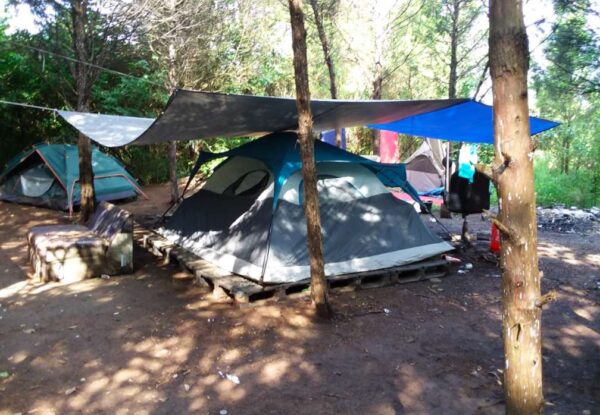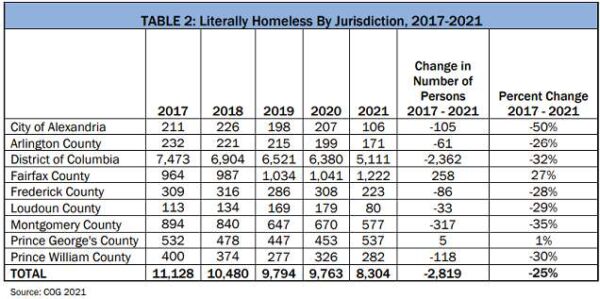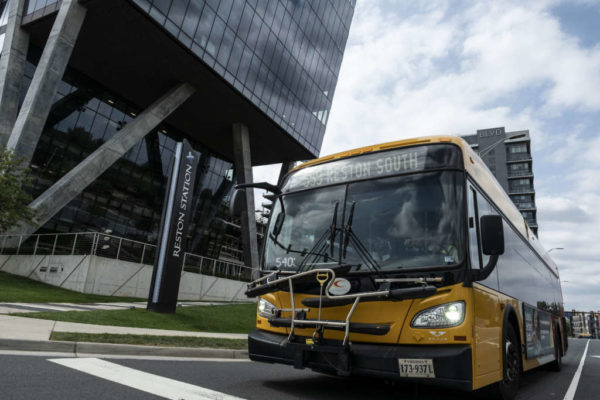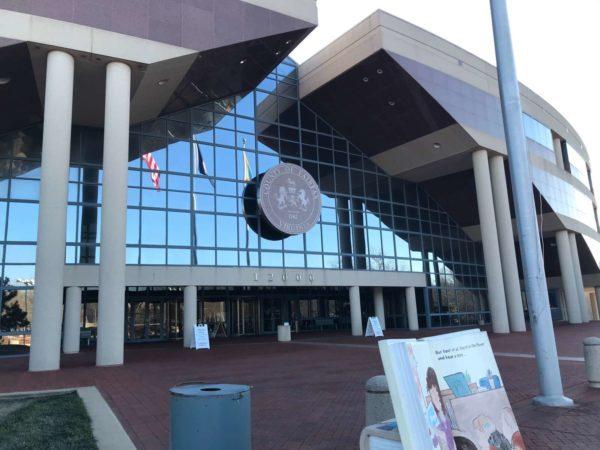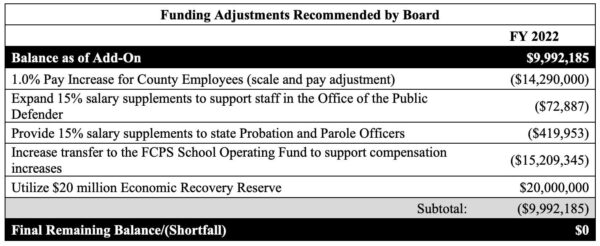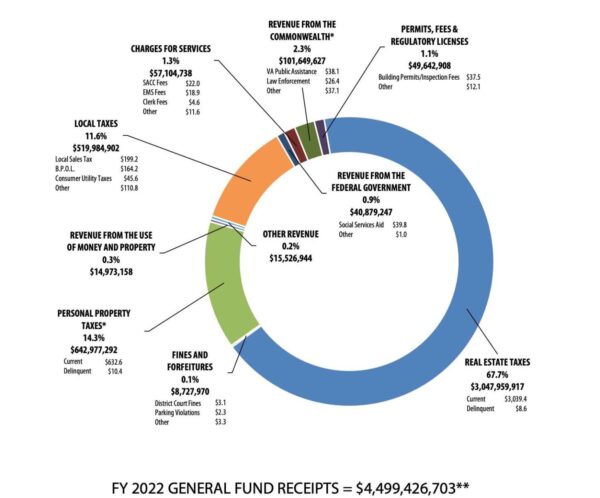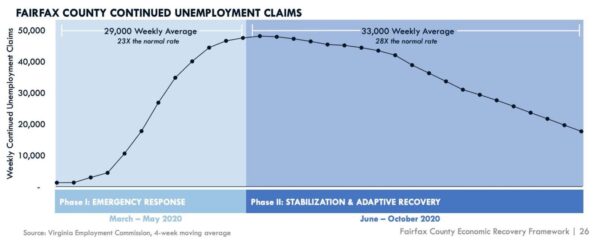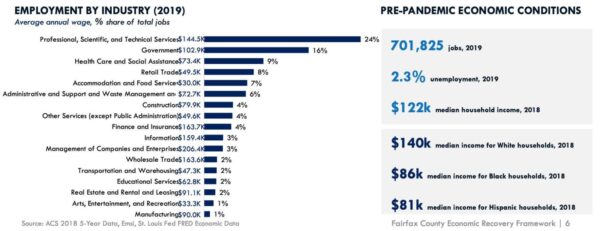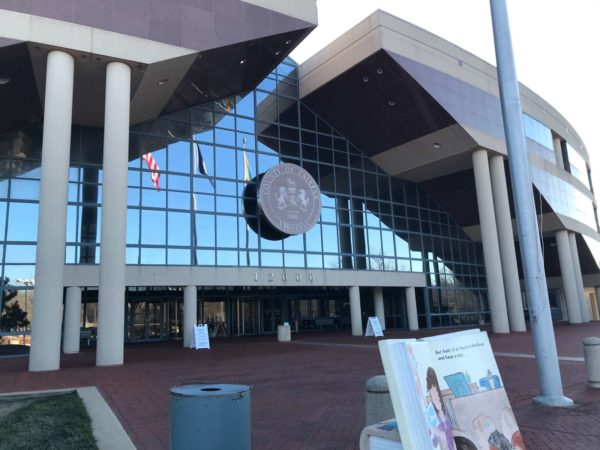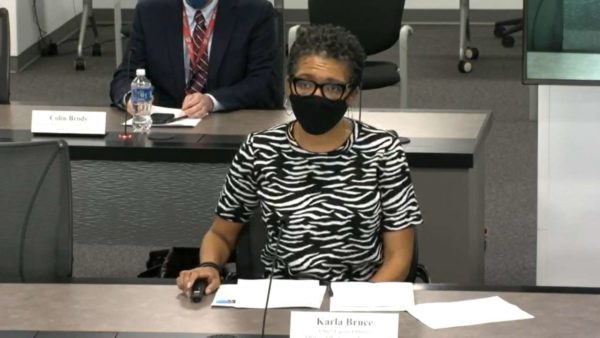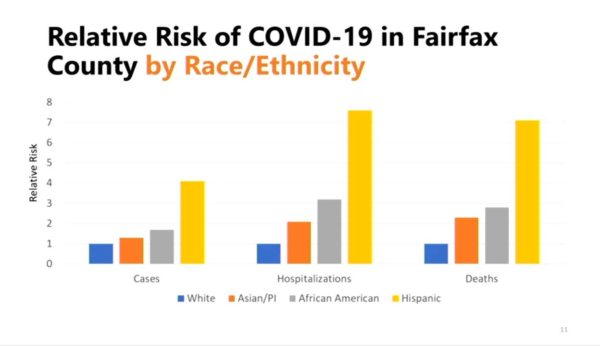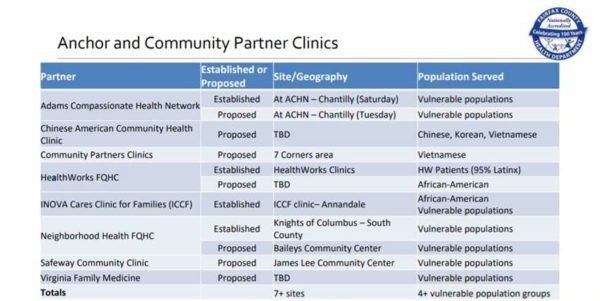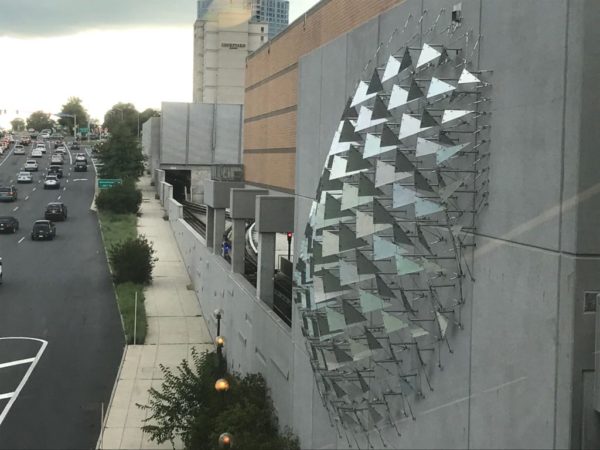A new report by the Metropolitan Washington Council of Governments (COG) highlights some remarkable regional success in reducing homelessness. In Fairfax County, the numbers seemed to tell a different story, but county leadership says some of that is a result of the way the survey is conducted.
The annual study sends researchers across regional localities to collect a snapshot of how many residents are experiencing homelessness, and while not a comprehensive scientific count, it’s generally seen as a look at regional trends.
While neighbors like Arlington County and the City of Alexandria reported declines in their homeless population counts by 14% and 49%, respectively, Fairfax County is one of only two out of nine jurisdictions surveyed that saw its homeless count increase.
In Fairfax County, homeless population counts went from 1,041 in 2020 to 1,222 in 2021, a 17% increase. The only other D.C.-area locality to report a year-to-year rise in its homeless population was Prince George’s County, which increased by 19%.
Fairfax County claims on its website that the increase reflects an expansion of shelter capacity and services, rather than an increase in homelessness.
“The increase is primarily attributable to the increase in the community’s capacity to provide shelter with increased federal emergency funding associated with the COVID-19 pandemic, and the commendable efforts of service providers to care for unstably housed community members,” the Fairfax County Office to Prevent and End Homelessness said.
Fairfax County Board of Supervisors Chairman Jeff McKay similarly credited the increase in the count to an increase in accommodations for people experiencing homelessness.
“This year’s data indicates an outstanding effort by our Housing staff and our community-based partners to respond to the unprecedented impacts of 2020,” he said in a statement. “By providing safe housing accommodations and a wide variety of supportive services to assist our most vulnerable neighbors along the path toward housing stability, we have been able to help our entire community.”
However, since at least 2017, the homeless population counts for Fairfax County have been gradually increasing, which McKay says is also indicative of an inadequate affordable housing stock.
Released in two parts across 2018 and 2019, the county’s Communitywide Housing Strategic Plan set a goal of producing a minimum of 5,000 net new affordable housing units within 15 years. 1,800 units are currently in the pipeline, according to McKay.
In his statement on the homelessness point-in-time count data, McKay said:
Most importantly, it indicates that our work on the issue of housing — including emergency housing — must and will continue to be a critical priority for this Board. This is an essential component of our community’s crisis response system for those who need help in regaining a safe, decent and stable housing situation.
Housing is a foundational component in achieving positive outcomes in nearly every aspect of our lives and having thousands of our neighbors experiencing homelessness or struggling to remain in their homes is not something that we as a community will turn a blind eye to. This could be any of us. There are too many circumstances beyond our control which can cause that stability to be shaken through no fault of our own.
Photo via MWCOG
Fairfax County is taking a small but crucial first step toward electrifying its sprawling government vehicle fleet, thanks to more than $4 million in state grants.
Gov. Ralph Northam announced on Friday (May 7) that the county will receive $4.4 million from the first round of Virginia’s Clean Air Communities Program, an initiative that launched in November using $20 million from the state’s Volkswagen Environmental Mitigation Trust.
Three of the five awarded grants went to Fairfax County agencies:
- Department of Transportation: $2.9 million for four shuttle buses and chargers
- Department of Public Works and Environmental Services: $1.2 million for four solid waste and recycling trucks and chargers
- Department of Vehicle Services/Department of Procurement and Material Management: $205,275 to purchase a medium-duty truck and charger for the public library system
The other recipients are the Metropolitan Washington Airports Authority, which will get $3.9 million to purchase five shuttle buses and chargers, and Amherst County, which got $998,301 for two trucks, a shuttle bus, and chargers.
“Supporting clean transportation solutions is a vital part of our efforts to combat climate change and improve air quality in the Commonwealth,” Northam said. “These investments will reduce harmful vehicle pollution, which disproportionately impacts marginalized communities, and help accelerate an equitable transition to a cleaner economy for all Virginians.”
Fairfax County will use its grant funds to launch an electric vehicle pilot as part of a broader push to eliminate fossil fuels from the county’s transportation operations and achieve carbon neutrality by 2040.
The county’s Joint Environmental Task Force recommended in October that the Fairfax Connector bus fleet transition to electric vehicles or other non-carbon-emitting alternatives by 2030, followed by public school buses and non-bus vehicles in 2035.
The county has approximately 6,347 vehicles in its overall fleet, including 1,540 Fairfax County Public School buses, according to the Department of Vehicle Services.
While the new pilot will kick off the conversion of the county government fleet, FCPS received its first electric school buses in January from a statewide initiative led by Dominion Energy, which has pledged to replace all diesel buses in the state with electric ones by 2030.
The county first utilized electric vehicles for public transit in November, when the autonomous Relay shuttle kicked off passenger service in Merrifield for a year-long pilot project.
“To cut carbon admissions, we have to reimagine the way in which we travel,” Fairfax County Board of Supervisors Chairman Jeff McKay said. “As a county, we are already actively moving towards cutting our emissions from our public transit and this will move us closer to our end goal.” Read More
The Fairfax County Board of Supervisors adopted a balanced budget for fiscal year 2022 yesterday (Tuesday).
It includes some funding adjustments that the board incorporated into the proposed budget during the board’s markup session last week.
The newly adopted budget supports a 1% pay increase for county employees, a 2% raise for Fairfax County Public Schools employees, and 15% salary supplements for staff in the Office of the Public Defender and state probation and parole officers.
“While there were many constraints on this year’s budget, I am tremendously proud of what this Board was able to accomplish,” Board Chairman Jeff McKay said. “My goal was to look for balance in lowering the tax rate, with the understanding of skyrocketing property assessments, while also supporting our County employees and teachers and furthering our priorities in education, affordable housing, environmental protection, and community resources. I am pleased we were able to achieve that.”
The proposed budget from February did not include pay increases for employees, whose pay was frozen in this year’s budget. The new 1% pay increase comes after Fairfax County employees advocated for salary bumps last month.
“The 1% wage increase and one-time bonus come as a response to union members making it clear that two years of frozen pay for essential county workers was unacceptable,” SEIU Virginia 512 Fairfax Chapter President Tammie Wondong said. “We appreciate the approved change. That being said, the concessions fall short of the agreed-upon pay plan and workers are falling behind.”
The county employees’ union will now focus on its push for Fairfax County to adopt a collective bargaining ordinance. A new state law permitting localities to establish collective bargaining procedures took effect on May 1.
McKay said last week that county staff is drafting an ordinance that will be discussed at the board’s personnel committee meeting on May 25.
“Meaningful collective bargaining is the only way workers can ensure that the county keeps their promise on our pay plans so that we have the resources to provide the best services to the Fairfax community,” Wondong said.
The increase will be funded using $20 million that County Executive Bryan Hill had recommended setting aside in an “Economic Recovery Reserve.” As the county looks to rebuild, it will instead lean on the $222 million in federal relief funds it expects to receive from the American Rescue Plan Act.
“The redirection of this reserve does not exacerbate budgetary challenges in FY 2023,” the final budget document reads. “With this reserve, funding just shy of $30 million is available to be utilized for employee pay in FY 2022.”
Here are some other highlights:
As proposed in February, the real estate tax rate will decrease from $1.15 per $100 of assessed value to $1.14 per $100 of assessed value. Personal property tax rates and stormwater fees will remain the same, at $4.57 per $100 of assessed value and $0.0325 per $100 of assessed value, respectively.
As considered during the budget markup last week, the refuse disposal fee will decrease from $68 to $66 per ton, but the refuse collection fee will increase from $370 to $400 per household. The rate was reduced from $385 last year because of a reduction in yard waste collection services during the pandemic.
Funding for county government operations and contributions to Metro and Fairfax County Public Schools, or general fund disbursements, totals $4.53 billion. That marks a slight increase from the advertised $4.48 million, and an increase of $55.40 million over the current fiscal year’s disbursements.
More than half of those disbursements (52.6%, or $2.38 billion) support Fairfax County Public Schools. This includes $2.17 billion for operations, $197.12 million for debt service and $13.10 million for school construction.
Fairfax County will create 109 additional positions in FY 2022 to staff new facilities, such as the South County Police Station, a new 61,000-square-foot police station and animal shelter, and the Scotts Run Fire Station. Positions are also being added for the county’s opioid task force and Diversion First initiative.
Fairfax County Commonwealth’s Attorney Steve Descano says the budget marks an important first step toward solving Fairfax’s “longstanding justice crisis,” adding that the 15 new positions his office has been allocated will enable prosecutors to take on more cases.
“As the budget takes effect in July and we fill those, we will be able to expand our caseload to encompass all cases other than minor traffic infractions,” the Commonwealth Attorney’s office said. “We are already scaling up our caseload now and are prioritizing cases that contain an indication of violence between now and July.”
Descano says his office will complement its expanded case load with a “growing use of diversion and alternative sentencing to ensure we are keeping the community safe in a manner that accords with our values.”
Additional staffing alone won’t solve the problem, however. Descano says a multi-year investment is needed to address the “chronic shortcomings that plagued our system,” including a culture of producing as many convictions as quickly and cheaply as possible.
Charts via Fairfax County
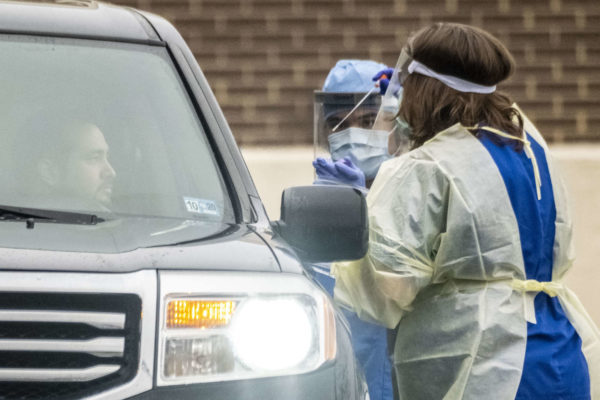
Fairfax County has been awarded approximately $3.3 million in federal funds to cover the costs of personal protective equipment, Sens. Tim Kaine and Mark Warner announced on Wednesday (April 14).
The funds come from the Federal Emergency Management Agency and will be used to purchase and distribute masks, respirators, eye and face shields, and other PPE necessary to protect county workers during the COVID-19 pandemic, according to a joint news release from the senators’ offices.
The money can also go toward tents, bags, door openers, and tables utilized by workers as part of the county’s pandemic response.
“We’re glad to see these federal dollars go towards managing, controlling, and reducing the spread of the COVID-19 virus,” Warner and Kaine said. “As Virginians continue to wear a mask, social distance, and get tested and vaccinated, we remain committed to ensuring that the Commonwealth has the necessary tools to continue to combat this health crisis.”
Fairfax County Board of Supervisor Jeff McKay says that, so far, FEMA has approved $11.5 million in requests for financial assistance from the county, including public assistance reimbursements for PPE, disinfectants, plexiglas, and communications expenses related to public health orders during the pandemic.
“I am appreciative of FEMA’s responsiveness in approving our submissions,” McKay said.
McKay’s office confirmed to Tysons Reporter that Fairfax County will receive $402 million in COVID-19 stimulus funds from the American Rescue Plan, the federal relief package passed by Congress and signed into law by President Joe Biden in March.
About $179.7 million will go to Fairfax County Public Schools, while the remaining $222.5 million will go to the county government. In addition, the Town of Vienna is expected to receive close to $15 million, and $2.8 million will be allocated to the City of Falls Church, according to Inside NoVA.
McKay says Fairfax County is still waiting for “specific guidance” from the Treasury Department for how to utilize its stimulus money, but the county hopes to continue initiatives like the Fairfax RISE grant program that were supported by previous relief funds.
“We expect the funds to be more flexible than the CARES Act funding so we will need some time to see what our options are,” McKay said. “Regardless, we are excited to have the support of the federal government and believe it will be crucial to continue to lift up our community.”
According to a March 12 memo from County Executive Bryan Hill, Fairfax County had finished allocating more than $200 million in the Coronavirus Relief Fund that it created with money from the CARES Act. The funds went to support public health programs, county government operations, and virtual learning at FCPS and to provide assistance for residents and businesses.
Hill also noted that the county will also receive additional funds from the American Rescue Plan for its emergency rental assistance program, though the memo doesn’t specify the amount.
Kaine and Warner announced on April 8 that Virginia will get more than $96 million, including $7.8 million for Fairfax County, to support access to safe and affordable housing for people who are experiencing homelessness or at risk of losing their homes.
The Board of Supervisors will formally accept its American Rescue Plan stimulus funds on April 27 when it approves the county’s fiscal year 2021 third-quarter review, according to Hill.
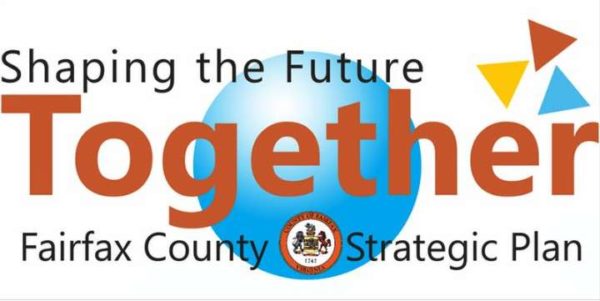
Time is running out for community members to weigh in on Fairfax County’s first Countywide Strategic Plan, which will serve as a template for the county government’s vision and priorities for the next two decades.
A public survey on the strategic plan will close at the end of today (Thursday), though the county plans to conduct a fourth round of community engagement this summer before the document is revised and ultimately adopted in October.
The survey is available in English, Spanish, Vietnamese, Chinese, Korean, Arabic, Urdu, and Farsi. A form for individuals to submit more general feedback can also be found at the bottom of the strategic plan website.
“We view community engagement as a process that is never complete, and strongly encourage you to see the ways the strategies within this plan will positively impact your daily lives,” County Executive Bryan Hill said in a note to the community. “We are counting on you to help us track success, as well as how we can continue to improve — this is not only a government plan, but a way to shape our collective future in a way that benefits us all.”
The effort to develop a single, cohesive plan for the county’s future launched in early 2019 with an initial round of community engagement.
Hill presented what was supposed to be a final version of the document to the Fairfax County Board of Supervisors on Feb. 25, 2020, but the county decided to pause work on the initiative when the COVID-19 pandemic arrived in March 2020.
After the county spent a year revising the document to take into account the pandemic’s impact, Hill delivered a new proposed strategic plan to the board on Feb. 23, alongside his presentation of the county’s advertised Fiscal Year 2022 budget.
The Board of Supervisors was previously scheduled to adopt the plan in conjunction with its mark up of the budget on April 27, but county staff agreed to push the adoption date back to Oct. 5 after “several” supervisors suggested more time was needed for both the board and the public to review the plan and provide input.
“We absolutely think that this makes sense, because while we recognize that the plan was originally designed to be flexible, adaptable, and future-oriented, we also recognize that COVID is our first real test of that design,” Countywide Strategic Plan Coordinator Aimee Brobst said during a budget committee meeting on March 16. “We want to ensure that the board has adequate time to fully focus on the countywide initiative that we, of course, consider to be extremely important.”
The 56-page strategic plan currently being considered categorizes the county’s goals and strategies for achieving those goals into nine priority areas:
- Cultural and recreational opportunities
- Economic opportunity
- Effective and efficient government
- Empowerment and support for residents facing vulnerability
- Health and environment
- Housing and neighborhood livability
- Lifelong education and learning
- Mobility and transportation
- Safety and security
In his note, Hill says that the pandemic has exacerbated existing health and economic disparities in Fairfax County, while posing “significant current and future budget challenges that will require us to focus our limited resources on our top strategic priorities and most urgent community needs.”
“Now more than ever, we must intentionally align existing government and community plans and priorities to respond to the areas of greatest importance to our residents, and strategically focus our resources on these priorities over the next 5, 10, 20 years and beyond,” Hill said.
Image via Fairfax County
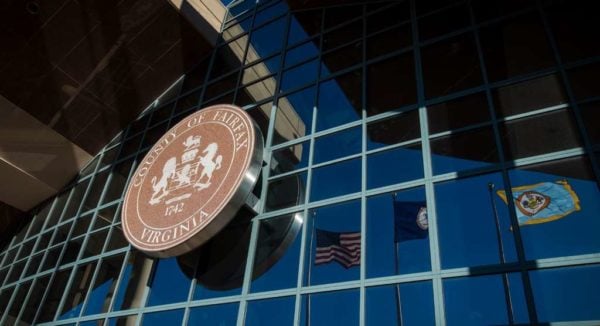
With tax season in full swing and Fairfax County plugging away at its latest budget proposal, you may wonder where exactly your tax dollars go.
Fairfax County is hammering out the details of its spending for the 2022 fiscal year, which is expected to gross more than $8.5 billion. But your tax dollars go to a smaller piece of the pie that encompasses funding for county government operations and contributions to Metro and Fairfax County Public Schools.
Totaling $4.48 billion, the general fund disbursements money comes from taxes — primarily real estate and personal property taxes, but also taxes on hotels and retail sales — as well as fees for licenses and permits. About $1.6 billion of this bucket sustains the operations of all county departments.
Real estate taxes paid by individuals and businesses contribute about $3 billion (or 68%) of the money needed to support county departments, schools, Metro, and debt services. In fact, residents’ property taxes make up about 74% of the county’s real estate tax income. The rest comes from commercial properties, such as apartments, offices, retail spaces, and hotels.
While homeowners could see their real estate tax rate lowered by one cent to $1.14 per $100 of assessed value in the upcoming budget, they will likely still see their bill increase due to rising property values. The one-cent reduction, however, will bring in $27 million less than if the current rate remained in place.
The county, meanwhile, is contending with falling commercial property values for its income from non-residential real estate taxes, a nationwide phenomenon.
But where does this tax revenue go?
After schools, which receive slightly more than half of the general fund disbursements, the county’s next two largest allocations go to public safety, including police and fire, and health and welfare, including family and neighborhood services.
Within those areas, much of the recurring spending is tied to personnel, both existing staff and requests for additional hires. The county government says an additional 109 positions are needed to staff new facilities and continue initiatives previously funded by grants and stimulus funding.
County Executive Bryan Hill’s proposed FY 2022 budget devotes $11.91 million to fund 46 positions to continue implementing the police department’s body-worn camera program and to staff the South County Police Station, a new 61,000-square-foot police station and animal shelter, and the Scotts Run Fire Station.
There is also additional funding to support the Fairfax County Office of the Commonwealth’s Attorney, which Commonwealth’s Attorney Steve Descano said last year is in a state of crisis and needs more staff, especially to handle the body-worn camera program.
The proposed budget adds seven positions to the county’s opioid task force and five positions for the Diversion First initiative.
Police and fire are the biggest drivers of the public safety budget, each accounting for around 41% of expenses, or $219 and $218 million, respectively. Overall, public safety accounts for 33% of the total general fund direct expenditures of $1.6 billion. Fairfax County lands in the middle of Virginia localities for how much it spends per person on public safety ($671 per person). Read More
Document Shredding Schedule Set for Fairfax County — The county’s solid waste management program has set the schedule for document shredding. The next shredding date is this Saturday. [Fairfax County Government]
COVID-19 Vaccine Form Now Available in Spanish — The county’s vaccine registration form is now available in Spanish. Users can toggle between the English and Spanish versions of the form by selecting language on the top right of the screen. [Fairfax County Government]
Drive-In Movies Take Place in Isaac Newton Square Parking Lot — Reston Association is holding its first drive-in movie event at 7:30 p.m. this Saturday. The event is $40 per car for RA members and $50 for all others. [RA]
Northern Virginia Reports Rise in COVID-19 Cases — “The Virginia Department of Health reported 674 new cases in Northern Virginia on Thursday, the most since Feb. 13. The region’s seven-day average of new cases, which peaked Jan. 18 at 1,628.4, had fallen as low as 318.4 on Saturday, but now stands at 407 cases per day.” [Inside NoVA]
Photo via vantagehill/Flickr
A consultant is recommending a dozen ways Fairfax County can uplift people whose livelihoods have been harmed by the pandemic in the short-term and promote long-term economic resilience.
Specific short-term measures include launching “Buy Local” and “Made in Fairfax” campaigns, focusing on women- and minority-owned businesses, and finding ways to reduce rent or other costs for struggling small businesses.
Other recommendations target those hit hardest — including people without high school degrees, women with children, and people of color — with services like career centers, workforce training programs, and affordable childcare.
“A lot of these things have ongoing aspects, but tying them together and focusing on economic recovery is really going to be an effective approach,” Dranesville District Supervisor John Foust said.
County staff presented plans for implementing the consultant’s recommendations and assisting small businesses during the Fairfax County Board of Supervisors economic initiatives committee meeting on Tuesday (March 16).
Fairfax County has up to $15 million in reserves to support economic recovery efforts and could also use some of the anticipated $222.56 million in federal funds coming from the American Rescue Plan, according to Foust, who chairs the committee.
Hunter Mill District Supervisor Walter Alcorn called the staff proposal “fantastic” but added that transportation — which did not figure into staff planning — should play a role in the county’s recovery efforts.
“Since we’re doing something new, I would just recommend putting more structure into collaboration across agencies,” Providence Supervisor Dalia Palchik said.
Fairfax County hired the consultant HR&A last summer to analyze how the COVID-19 pandemic has affected its economy and what the county government could do to expedite a more just recovery. More than 65 organizations and small businesses participated in the study, providing input on perceived barriers to and strategies for economic recovery.
According to the consultant’s report, before COVID-19, flourishing technology and government sectors contributed to a decade of strong economic growth for Fairfax County. The total number of jobs grew by 9% annually, and employment had reached its lowest level since the Great Recession.
In 2018, the county had the third-highest median household income in the D.C. area, but significant racial disparities lurked just below the surface: The median household income for white residents was about $140,000, exceeding that of Black households (~$86,000) and Hispanic households (~$81,000).
The pandemic reversed that job growth and exacerbated the existing disparities.
Through December 2020, Fairfax County lost an estimated 48,200 jobs, mainly in food service, hospitality, retail, and the arts. Small businesses in these three sectors will have a particularly long road to recovery, HR&A said.
The consultant also reported that job losses were most acutely felt by low-income people, people of color, and people with lower levels of formal education and training, which will make “the road to economic stability longer and more challenging.”
The job market appears to have settled down since the upheaval of the pandemic’s early days, when initial unemployment claims in Fairfax County soared to a high of 21,302 filings during the week of April 4. The Virginia Employment Commission reported today that 543 people filed new claims for the week of March 6, though the numbers ticked back up over 1,000 for multiple weeks over the winter.
HR&A outlined several ways Fairfax County can facilitate job opportunities for those suffering the most, namely, getting people who lost jobs in hard-hit industries access to jobs in industries that have weathered the pandemic better, including government and technology.
In the short-term, HR&A recommends Fairfax County employ artists to design public service announcements or put on performances. The county could also hire workers to fill temporary needs like contact-tracing, while partnering with the private sector to place people in long-term jobs.
Home to more than 8,900 technology-focused businesses, Fairfax County could pursue policies that support workforce training in health technology, digital services, and green jobs. Given its proximity to D.C., Fairfax County will continue attracting government workers, so the county should keep expanding the workforce pipeline for government and contracting work, the firm said.
The workforce will likely need skills training to acquire new qualifications, as well as equal digital access and digital literacy and adequate childcare access. This will require investing in job centers, improving certification and training programs, and making it easier to connect people with county and private services, HR&A writes.
In the long-term, the consultant recommends Fairfax County continue efforts such as easing online permitting processes and contributing to affordable housing.
Photo via Tim Mossholder on Unsplash
Virginia to Get Its Own Voting Rights Act — Democrats in the state’s General Assembly have passed their own version of a voting rights act. The move creates broad new protections against voter discrimination. [Virginia Mercy]
COVID-19 Deaths Top 10,000 — The state has surpassed 10,000 deaths associated with COVID-19. This past Sunday was designed as a day of prayer and remembrance to honor Virginians who died from the novel coronavirus. [Reston Patch]
Reston Association Parks and Recreation Committee Under Reform — The advisory committee is seeking members for the association’s committee. Members will be selected by the Board of Directors. [RA]
County Launches Survey on Strategic Plan — After a year-long hiatus, the county is resuming work on its strategic plan. A survey on the proposal is online. [Fairfax County Government]
Photo via vantagehill/Flickr
The Fairfax County Board of Supervisors unanimously agreed to defer a vote on adopting a new county zoning ordinance after hearing roughly five hours of testimony at a public hearing on Tuesday (March 9).
The fate of the 614-page document will now be decided at 4:30 p.m. on March 23.
“We’ve been at this for a long time,” Sully District Supervisor Kathy Smith said toward the end of the public hearing, which featured 71 speakers. “…By deferring for two weeks, that gives the board more time to consider what we’ve heard before we move on this on March 23.”
The additional time will let the board review input from the community and the Fairfax County Planning Commission, which put forward amendments last week related to flags and flag poles, home-based businesses, and accessory living units (independent housing on the same property as a main residence).
“I think we might have a fairly long mark-up on this, because my guess is there are going to be a number of issues, as a board, we might need to talk through,” Hunter Mill District Supervisor Walter Alcorn said.
Launched in 2017, the Fairfax County Zoning Ordinance Modernization project (zMOD) aims to update the county’s 40-year-old zoning code by making it easier to comprehend and incorporating new activities, such as electric vehicles and community gardens.
Proposed regulations on ALUs, home-based businesses, and flags have emerged as the most hotly contested changes, though speakers at Tuesday’s public hearing raised concerns about everything from food trucks to vehicle storage.
Fairfax County staff agreed with the planning commission that the draft should have a requirement that home-based businesses be approved by the county health department if the property has a well or septic system and a standard limiting the amount of hazardous materials they can have on site.
They also revised their recommendation for flags to allow maximum sizes of 50 square feet on lots with single-family dwellings and manufactured homes or 150 square feet for all other uses. Staff previously recommended limiting flag sizes to 24 square feet on single-family home lots and 96 square feet for other uses.
Community members took stands on both sides of the debate around ALUs. Some voiced support for looser regulations to enable them as an affordable housing option, while others worried about the potential impacts on traffic, parking, and public facilities.
“There is no guarantee that ALUs will equal affordable housing, but eliminating the current requirements will tax our already burdened public facilities,” McLean Citizens Association President Rob Jackson said. “…Adding more people without additional public facilities will degrade the quality of life.”
Many speakers urged the Board of Supervisors to follow the planning commission’s recommendation of retaining a special permitting process for interior ALUs, saying that allowing administrative permits would shut out citizens and neighbors.
“We really need more genuine outreach to engage the public in making land use decisions that directly affect communities, and not less,” Falls Church resident Kathryn Cooper said. “Residents do not want their involvement in land use decisions to be excised, as will occur under zMOD.”
Also a Falls Church resident, Coalition for Smarter Growth Northern Virginia Advocacy Manager Sonya Breehey argued that the county should go further in encouraging ALUs and that continuing to require a special permit for interior units, as recommended by the planning commission, would delay efforts to address housing affordability challenges.
“Accessory living units can offer less expensive housing options than renting or buying a single-family home because of their smaller size, and they provide housing opportunities in communities that might otherwise be too expensive,” Breehey said. “…As a homeowner in a single-family residential neighborhood, I want you all to know that I see ALUs as an opportunity to provide greater inclusivity in my neighborhood that I love.”

As Fairfax County moves to expand its use of renewable energy, the Board of Supervisors is looking for feedback on the next round of county facilities being considered for solar panel installations.
The board will hold a public hearing on Tuesday (March 9) to determine whether the county should lease roof space at 22 county-owned properties to the energy company Sigora Solar, which would be responsible for installing, operating, and maintaining solar photovoltaic panels at the sites.
Sites under consideration in the Tysons and Reston area include:
- McLean Government Center and Police Station (1437 Balls Hill Road)
- Wolf Trap Fire Station #42 (1315 Beulah Road)
- McLean Community Center (1234 Ingleside Avenue)
- Thomas Jefferson Library (7415 Arlington Boulevard)
- Merrifield Center and Kerrifield Center Garage (8221 Willow Oaks Corporate Drive)
- Reston Fire Station (1820 Wiehle Avenune)
- Great Falls Volunteer Fire Station (9916 Georgetown Pike)
This is the second set of properties that county officials have proposed as possible locations for solar panels. The county previously approved leases for roof space at eight sites, including the Providence Community Center, in October.
In an effort to pivot to renewable energy as a means of reducing greenhouse gas emissions, Fairfax County announced in December 2019 that it had awarded contracts to multiple solar power companies in what was the “largest solar power purchase agreement initiative by a local municipality in Virginia” at that time, according to the Fairfax County Office of Environmental and Energy Coordination.
In addition to Sigora Solar, the county has contracted with the providers BrightSuite — a subsidiary of Dominion Energy — and Ipsun Solar for the initiative, which could also include Fairfax County Public Schools facilities.
In the board package for Tuesday’s meeting, county staff say there is no expected net cost from the solar panels. Sigora Solar has offered a fixed rate of $0.069 per kilowatt per hour (kWh) on a 25-year contract term. The county will save $0.016 per kWh compared to current electric costs which will help pay off the costs of installation and upkeep to Sigora Solar.
The public hearing is expected to start around 4 p.m. Like the rest of the Board of Supervisors meeting, it will be available to watch via the county’s cable TV channel and online live stream, and live audio can be accessed by calling 703-324-5300.
Image via Flickr/Minoru Karamatsu
Hispanic residents of Fairfax County are seven times more likely to die from COVID-19 than their white, non-Hispanic counterparts when adjusted for variations in age, county data suggests.
Fairfax County Director of Epidemiology and Population Health Dr. Benjamin Schwartz reported that sobering trend to the Fairfax County Board of Supervisors during its health and human services committee meeting yesterday (Tuesday) as part of a broad overview of the county’s efforts to implement an equity-focused strategy to distribute COVID-19 vaccines.
Knowing that the pandemic has disproportionately affected communities of color, especially Black, indigenous, and Latino people, Fairfax County staff calculated the relative risk levels for infection, hospitalization, and death faced by different races and ethnicities, using white, non-Hispanic individuals as the control group.
According to the county, the results show that the risk of contracting COVID-19 is 1.8 times greater for Black people than for white people and four times greater for Latino or Hispanic people, who are also seven times more at risk of hospitalization.
In Fairfax County, Black people are being hospitalized at more than three times the rate of white people and are almost three times as likely to die from the disease.
Schwartz says the data focuses on community transmission, excluding long-term care facilities, and it has been adjusted for age, meaning it eliminates variances in age across different populations. It shows, for instance, that Latinos are more likely to die from or be hospitalized by COVID-19, even though the county’s Latino population is generally younger and older people are considered more at risk.
“This really highlights the social, economic, and medical risk factors pertaining to different groups in our county,” Schwartz said, mentioning large households, exposures through work, and underlying health conditions among the factors that have made some populations more vulnerable to COVID-19.
Fairfax County Chief Equity Officer Karla Bruce says the county is utilizing its COVID-19 Vulnerability Index as well as data showing the disease’s spread to identify areas that need a targeted approach for vaccine outreach and distribution, often because residents have limited access to medical care, transportation, and other public services.
“There are a lot of intersecting factors which are preventing people’s access to resources or access to the vaccine,” Bruce said. “So, we want to understand and look at how we might be better able to connect people to what will enable them to then connect to the vaccine.”
The county has been working with different community partners, including nonprofits and faith-based organizations, not only to counter vaccine hesitancy with education and trust-building, but also to identify people who are currently eligible to get vaccinated and register them for an appointment.
To improve the accessibility of the vaccine, the Fairfax County Health Department has been developing a network of community-based partner clinics that is expected to grow in the coming weeks, as seen in the slide below:
Schwartz says the Neighborhood Health federally qualified health center at the Bailey’s Community Center and the Safeway community clinic at the James Lee Community Center in Falls Church will start administering vaccinations this coming weekend.
The health department is also looking at sites in Lorton, Springfield, and Centreville, but the agreements are still being finalized.
“It will take a couple of weeks to have our clinics established, to confirm medical and non-medical staff for those clinics, and to get into a rhythm with the vaccinations,” Schwartz said. “But we are anticipating making substantial progress to reduce disparities in who receives vaccination in the county.”
Photo via Fairfax County, slides via Fairfax County Health Department (1, 2)
What would it take for you to reduce your carbon footprint?
That’s the question Fairfax County is posing as it enters the public engagement portion of its Community Energy and Climate Action Plan (CECAP) initiative, which will establish goals and strategies for reducing greenhouse gas emissions and mitigating the impact of climate change.
Launched in early 2020, the CECAP process is being led by the Fairfax County Office of Environmental and Energy Coordination (OEEC) with support from the Metropolitan Washington Council of Governments and the Fairfax-based consulting firm ICF.
The county previously sought public input on the plan in August and September, when a CECAP Task Force started developing draft mitigation goals.
In addition to holding two public meetings last week, one focused on energy and another on transportation, waste, and development, the county is looking to gather more public feedback through a trio of short surveys.
“We want to make sure that we expand our reach and get information from as many county residents and business owners as we can,” ICF Director of Human Capital Michelle Heelan said when facilitating the energy community meeting on Feb. 23.
One survey gauges respondents’ interest in undertaking projects to make their home more energy-efficient and sustainable, like installing solar panels and replacing light bulbs and HVAC systems. Another deals with transportation and development, asking questions about public transit, electric vehicles, and mixed-use development.
There is also a more open-ended survey for people to share general comments on the CECAP initiative.
“In Fairfax County, energy use and transportation are the two greatest sources of greenhouse gas emissions,” the OEEC says. “The CECAP will address both issue areas, and with your input, we can ensure that the final plan reflects the needs of everyone in our community as we work to reduce our collective carbon footprint.”
The surveys are currently available in English, Spanish, Korean, and Vietnamese. They will be open until 11:59 p.m. on Mar. 14.
ICF will draft a final report with input from a CECAP Working Group and the community for the Fairfax County Board of Supervisors to adopt this summer, according to OEEC Senior Community Specialist Maya Dhavale.
Self-Driving Cars Make Local Debut — Self-driving cars from Optimus Ride are now navigating DC’s waterfront, available for pick-ups in the Yards with access to Barracks Row and Capitol Hill. Rides are currently limited to a select group of tenants in waterfront apartment buildings, similar to when the service made its DC-area debut at the Halley Rise mixed-use development in Reston. [Washingtonian]
Stolen Dodge Charger Recovered by Police — Officers in the Reston District Station of the Fairfax County Police Department recently recovered an automobile that had been reported stolen in the Herndon area of the county, according to the weekly crime report. [Reston Patch]
Members Sought for County Board of Appeals — The county’s Board of Zoning Appeals has openings for two members. Interested candidates should apply by Monday, March 1. [Fairfax County Government]
Photo via vantagehill/Flickr
Reston Association Has No Plans to Remove Snow with Plows — The association does not plan to remove snow on its pathways because they do not have enough snow on them for the organization to safely operate the plows. Instead, crews have removed high traffic areas by hand. [RA]
Virtual Instructional Job Fair Set for Feb. 20 — Fairfax County Public Schools is hiring a virtual job fair on Saturday, Feb. 20 from 8-11:30 a.m. Virtual interviews are planned from Feb. 22 through March 5. [FCPS]
Fairfax Connector Issues Reminder of Mask Requirement — ‘Fairfax Connector passengers are reminded that they must wear a mask or a face covering, as now federally mandated, when taking public transit or visiting a transit hub in Fairfax County. This safety measure, which has been in place on board Fairfax Connector buses since May 2020, aims to protect passengers and bus operators during the ongoing COVID-19 pandemic.’ [Fairfax County Government]
Reston District Station Town Hall Set for Today — The police department will introduce its new data dashboard at a virtual meeting today at 5 p.m. [Zoom]
Photo via Marjorie Copson


